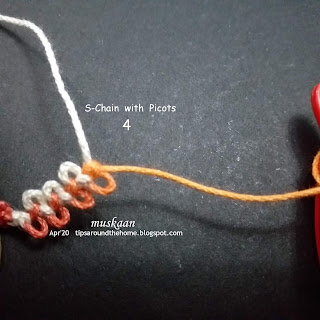Pin It now!
Colour
play without the shoe lace trick (SLT)!
Last
week when I went digitally AWOL, I was compiling a pdf package for the IOLI
Chapter Pattern/Gift CD, 2020. Instead of sending a single pattern, my recent
crosses from the magic square spurred the idea of an entire project based off those sketches. It would make a wonderful design exploration for groups. I need to convert some pdfs into shareable links - will post later.
After
sending them off, I couldn’t resist trying out the pinwheel sketch. So, here is
the ‘simpler version’.
Pinwheel
Coaster (or Tatted Quilt Block)
Adapted
from the vintage Magic Square
To
make it easier, I started with a black medallion of 4 rings. It should’ve been
smaller (my mistake!) – you can see how the adjoining chains have a shallow
dip.
The
correct stitch count for each ring is : (3-3-3-3), joining to previous ring and
to the first one at the end.
Notice
the numerous tails? Lots of scraps used in first 2 motifs. All knotless addition of thread, tatting
over tails in separate elements, and lots of False
CTMs (and more here) in order to start the chain as if the thread is continuous and
later add in new thread/colour. Remember to cross the new thread around the old one.
These
(and more below) ‘tricks’ kept the SLT away!!!
All
rings are 6-6, the first of each 4-ring cluster has a large central picot.
All
chains are 6 or 6-6-6.
Each
triangular motif is worked with one shuttle and ball.
I
wound 2 Pony shuttles separately one with yellow and other with orange and
these lasted for the entire coaster. Respective ball when needed.
Core
thread under 2-coloured outer chain and when joining to inner black ring, have
the core of same colour as start of chain.
The corner chains
show 2 colours. For this, the core thread remains the same as the first half
eg. yellow chain with yellow core. Midways, orange chain thread is added over
the yellow core. The yellow chain thread is snipped off and whip stitched back (since
I like to hide under different elements).
Similarly,
the inner chains that join to the black ring have the same core thread, but
different stitch colours. While making the join, I pulled up a loop of the new
colour ball, passed the shuttle through and worked the chain, hiding one tail.
The other tail was whip-stitched back.
Work
moves counter-clockwise and can be tatted all from the front using direct
tatted chains.
For the adventurous, this square can work as one block in a larger tatted quilt! Imagine the riot of designs and colours and shapes.
Each
side of this quilt block square is 9½ cms and 12½ cms diagonally in Anchor
Pearl Cotton size 8.
A
separate medallion in the center is the easier version. If one wants to tat
exactly like the sketch above, the inner 2-coloured ring can be worked as a
SCMR, adding the 2nd colour midways using this method of adding thread WITHIN a ring.
I
debated whether to add an edging. My sketched ideas looked good on paper, not in tatting - overkill! Ended up with a simple outline which hubby approved!
All chains are 6-6, lock join.
Corner chains are 2-2—2---2—2-2. (graduated
picots)
Avoid shoe lace trick: Keeping the SLT away
is a personal preference. In needle tatting, this knot is made after every
ring and chain, yet the lace looks beautiful. So for those who do not mind the
SLT, wind 2 shuttles, one with each colour, and make a SLT after each element
to shoe the colour you want. There won't be so many ends to add and hide then.
The same holds true for tatting this coaster. My notes pertain to how I approached it. Every tatter is free to choose their comfort tactics.
I will also share how to keep the colour blip on the backside when working and joining a chain backside. I've used this before, but not in this situation and I truly love the trick!


















































